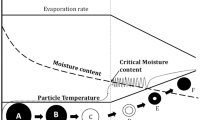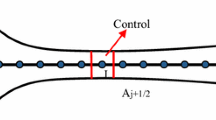Abstract
Heat transfer rates to spray droplets under conditions corresponding to those of spray transients in a pressurizer of pressurized water reactor (PWR) have been predicted by a simple droplet model with internal thermal resistance and partial internal mixing. In those processes, the temperature distributions in the droplet have been obtained using the integral method, and the physical properties of the saturated steam-hydrogen gas mixture surrounding the droplets are estimated applying the concept of compressibility factor and using appropriate correlations. Results have been provided for the temporal variations of total heat flux with its convection and condensation heat transfer components, dimensionless droplet bulk temperature and droplet flight distance. The effects of ambient pressure, initial droplet size, concentration of hydrogen gas in the mixture, initial injection velocity, and spray angle on the heat transfer of spray droplets have been discussed.
Similar content being viewed by others
Abbreviations
- A :
-
Cross-sectional area of a droplet
- Bi :
-
Biot number (=h t R/k i )
- C D :
-
Drag coefficient
- C p :
-
Specific heat at constant pressure
- D :
-
Derivative with respect to τ(=d/dτ)
- D 12 :
-
Mass diffusivity of steam in a mixture
- g :
-
Gravitational acceleration
- H fg :
-
Latent heat of condensation
- h c :
-
Convection heat transfer coefficient
- h t :
-
Apparent heat transfer coefficient
- J s :
-
Mass flux of steam
- k :
-
Thermal conductivity
- M :
-
Molecular weight
- m :
-
Mass of a droplet
- Nu :
-
Nusselt number (=2h c R/k m )
- P :
-
Pressure
- P gm :
-
Logarithmic mean gas pressure difference
- Pr :
-
Prandtl number (=μ m C ipm/k m )
- qL :
-
Sensible heat flux to a droplet
- qs :
-
Latent heat flux to a droplet
- qt :
-
Total heat flux to a droplet
- \(\bar R\) :
-
Universal gas constant
- Re :
-
Reynolds number (=2ρ m WR/μ m )
- γ:
-
Radial distance in spherical coordinate
- Sc :
-
Schmidt number (=μ/D 12 ρ m )
- Sh :
-
Sherwood number (=2βR/D 12)
- T :
-
Temperature
- t :
-
Time
- U :
-
Horizontal velocity component
- V :
-
Vertical velocity component
- \(\bar R\) :
-
Molar specific volume
- ν:
-
Specific volume
- W :
-
Velocity of a droplet (=U 2+V 2)1/2)
- x, y :
-
Cartesian coordinates
- Y :
-
Flight distance
- y i :
-
Volume fraction of each component in the mixture
- Z :
-
Compressibility factor
- α:
-
Thermal diffusivity
- β:
-
Mass transfer coefficient
- Θ b :
-
Dimensionless droplet bulk temperature (=T b -T 0)/(T ∞-T 0)
- θ:
-
Transformed temperature in dimensionless form
- μ:
-
Dynamic viscosity
- ξ:
-
Dimensionless radial distance in spherical coordinate
- ρ:
-
Density
- τ:
-
Dimensionless time (=α l t/R 2)
- ϕ:
-
Spray angle
- ω:
-
Acentric factor
- b :
-
Bulk
- c :
-
Critical value
- g :
-
Noncondensable gas
- i :
-
At the interface between the droplet and the mixture
- l :
-
Droplet
- m :
-
Mixture
- o :
-
Initial condition
- r :
-
Reduced value
- s :
-
Saturated steam or droplet surface
- ∞:
-
Ambient
- o :
-
Low pressure
References
Bergles, A.E., Collier, J.C. Delhaye, J.M. Hewitt, G.F. and Mayinger, F., 1981, “Two Phase Flow and Heat Transfer in the Power and Process Industries,” Hemisphere Publishing Co., New York.
Brokaw, R.S., 1955, “Estimating Thermal Conductivities for Nonpolar Gas Mixtures,” Ind. Eng. Chem., Vol. 47, No. 11, pp. 2398–2400.
Chung, J.N. and Ayyaswamy, P.S., 1977, “The Effect of Internal Circulation on the Heat Transfer of a Nuclear Reactor Containment Spray Droplet,” Nuclear Technology, Vol. 35, pp. 603–610.
Clift R., Grace, J.R. and Weber, M.E., 1978, “Bubbles, Drops, and Particles,” Academic Press., New York
Colburn, A.P. and Hougen, O.A., 1934, “Design of Cooler Condensers for Mixture of Vapours with Non Condensing Gases,” Ind. Eng. Chem., Vol. 26, pp. 1178–1182.
Dawson, R., Khoury, F. and Kobayashi, R., 1970, “Self-Diffusion Measurements in Methane by Pulsed Nuclear Magnetic Resonance” AIChE J., Vol.16, No. 5, pp. 725–729.
Dean, D.E. and Stiel, L.I., 1965, “The Viscosity of Nonpolar Gas Mixture at Moderate and High Pressures,” AIChE J., Vol. 11, No. 3, pp. 526–532.
Huang, L.J. and Ayyaswamy, P.S., 1987a, “Heat and Mass Transfer Associated with a Spray Drop Experiencing Codensation: A Fully Transient Analysis,” Int. J. Heat Mass Transfer, Vol. 30, No. 5, pp. 881–891.
Huang, L.J. and Ayyaswamy, P.S., 1987c, “Drag Coefficients Associated with a Liquid Drop Experiencing Condensation,” ASME J. Heat Transfer, Vol. 109, pp. 1003–1006.
Hughmark, G.A. 1967, “Mass and Heat Transfer from Rigid Sphere,” AIChE Journal, Vol. 13, No. 6, pp. 1219–1221.
Kulic, E., Rhodes E. and Sullivan, G., 1975, “Heat Transfer Rates Predictions in Condensation on Droplets From Air-Steam Mixtures,” Can. J. Chemical Engineering, Vol. 53, pp. 252–258.
Kulic, E. and Rhodes, E., 1977, “Direct Contact Condensation from Air-Steam Mixtures on a Single Droplet,” Can. J. Chemical Engineering, Vol. 55, pp., 131–137.
Lee, B.I. and Kesler, M.G., 1975, “A Generalized Thermodynamic Correlation Based on Three-Parameter Corresponding States,” AIChE J., Vol. 21, No. 3, pp. 510–527.
Linn, J.D.M., Maskell, S.J. and Patrick, M.A., 1988, “A Note on Heat and Mass Transfer to a Spray Droplet,” Nuclear Technology, Vol. 81, pp. 122–125.
Özisik, N., 1980, “Heat Conduction,” John Wiley Sons Inc., New York.
Reid, R.D., Prausnitz, J.M. and Sherwood, T.K., 1977, “The Properties of Gases and Liquids,” 3rd ed., McGraw-Hill Book Company, New York.
Stiel, L.I. and Thodos, G., 1964, “The Thermal Conductivity of Nonpolar Substances in the Dense Gaseous and Liquid Regions,” AIChE J., Vol. 10, No. 1, pp. 26–30.
Sundararajan, T. and Ayyaswamy, P.S., 1984, “Hydrodynamics and Heat Transfer Associated with Condensation of a Moving Drop: Solutions for Intermediate Reynolds Numbers,” J. Fluid Mech., Vol. 149, pp. 33–58.
Tanaka, M., 1980, “Heat Transfer of a Spray Droplet in a Nuclear Reactor Containment,” Nuclear Technology, Vol. 47, pp. 268–281.
Author information
Authors and Affiliations
Rights and permissions
About this article
Cite this article
Jo, JC., Lee, SK. & Shin, WK. Heat transfer of a spray droplet in a PWR pressurizer. KSME Journal 5, 130–139 (1991). https://doi.org/10.1007/BF02953612
Received:
Issue Date:
DOI: https://doi.org/10.1007/BF02953612




